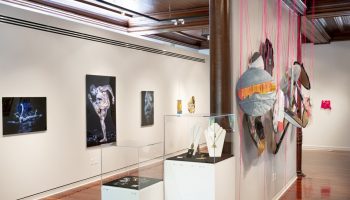Denise Bibro, who now operates her own art gallery in New York, was a political science major in college.
But Bibro, who will lecture at 7 p.m. Tuesday, July 31, in the Hultquist Center as part of the Visual Arts Lecture Series, was always interested in art. Bibro has lectured for the Visual Arts at Chautauqua Institution several times before, and Don Kimes, VACI’s artistic director, has had his own work featured in her gallery.
At her lecture tonight, Bibro will discuss how she runs her own gallery, her thoughts in general on the state of modern art galleries, and their evolution.
As a student at Columbia University, Bibro took painting and drawing classes for years, and considered becoming an artist herself. Since she was a teenager, Bibro worked in a New York sculpture center run by family friends from her home state of Connecticut. There, Birbro said she first caught “the bug” of wanting to work in art.
When Bibro was 18 or 19 years old, the sculpture center’s owners needed someone to watch the space — they trusted her with it. Then in college, Bibro received a grant from Columbia University to work as a gallery intern in New York.
“They asked me to stick around, so I stayed longer than my original grant to be with them,” Bibro said.
By the early 1980s, Bibro believed she had enough experience to run her own gallery. To fund the venture, Bibro sold all the antiques she’d accumulated over the years, saved money from staging art in corporate spaces and worked for a small local paper.
“(Opening a gallery) wasn’t originally my intention,” Bibro said. “But it evolved that way.”
She opened the gallery in SoHo, New York, in 1984. By the 1990s, SoHo rent was climbing and “Chelsea seemed appealing,” Bibro said. Now, the neighborhood is brimming with art galleries, but Bibro estimates hers was one of only 20 in 1996.
The Denise Bibro Fine Art gallery remains in that same Chelsea location today.
“Very soon after that, when I opened my first gallery, I realized I wasn’t going to do anything with political science,” Bibro said.
For the last six years, Bibro has tried to maintain a balance of up-and-coming and already-established artists by inviting the former to submit work via open calls. Bibro sorts through the submissions, selects her favorites, then embarks on studio tours to determine which will be featured in her own gallery.
“I try to show a broad range of established and emerging artists,” Bibro said. “It’s hard to juggle that because the economics are difficult, but I enjoy trying to introduce platforms of work that otherwise probably would not be seen.”
As a consultant, Bibro advises artists not selected to be featured in her gallery to remember to be “advocates” for themselves, as well as find galleries that will advocate for them.
When seeking out art for her own gallery, Bibro said she first determines “whether the artist has truly evolved, and whether there’s truth in the work.”
Some artists, she said, lack the kind of cohesiveness she’s looking for and aren’t ready for solo or group exhibitions yet.
“You seek out an artist that has a real voice, that’s developed a body of work,” Bibro said.
Bibro said that high-end galleries showcasing only established artists are paying the same rent as “medium” galleries featuring both new and established artists, leading to economic issues for the latter.
Anti-gallery articles are now “pervading” social media, Bibro said, spreading the message that the spaces are no longer important — a notion she wholly disagrees with.
“People should visit galleries because it’s a good way of educating themselves and broadening their horizons to see different mediums, different ways of expression,” Bibro said.
Her gallery has an active social media presence to spread word about upcoming events and exhibitions, and Bibro acknowledged that social media is important to the art world in some ways.
“I think (social media) is a tool, but on the other hand, I don’t think they’ll replace galleries,” Bibro said. “Galleries provide the public with a tremendous resource.
… In Chelsea, you can go to hundreds of galleries and see all different types of work, make decisions about that work, and you don’t have to pay for it.”






